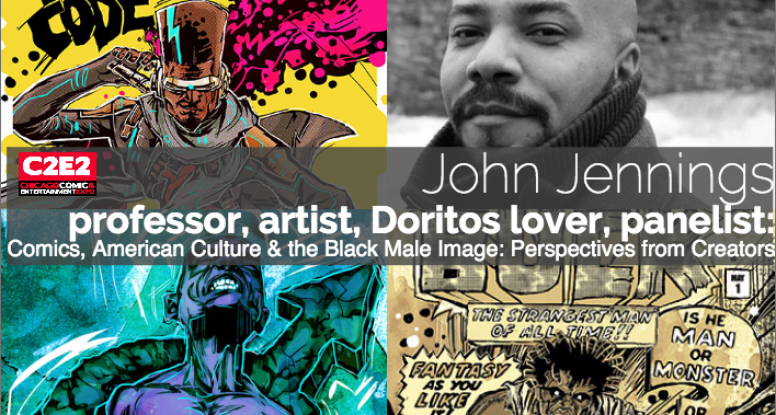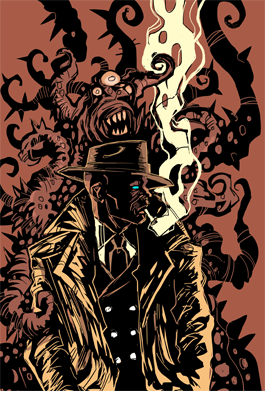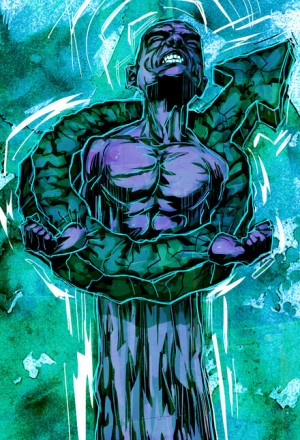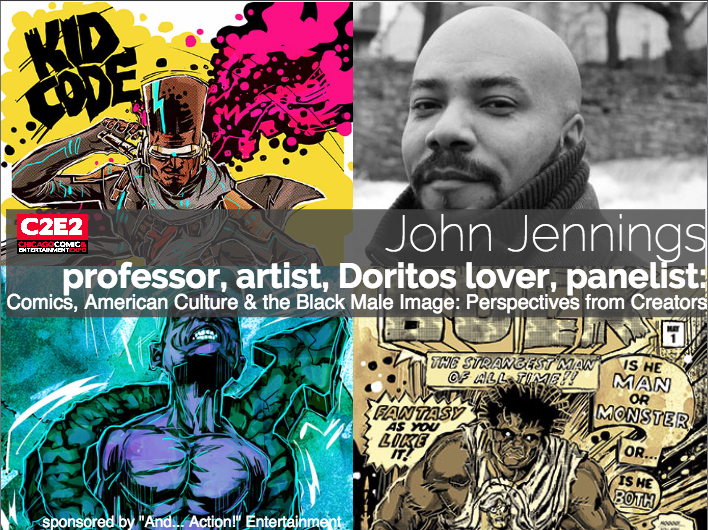
C2E2 News: Panelist John I. Jennings Talks Comics, American Culture & the Black Male Image
Here at “And… Action!” Entertainment, we are very excited about the selection of our panel proposal for next week’s Chicago Comics and Entertainment Expo. The Comics, American Culture & the Black Male Image: Perspectives from Creators panel is a fantastic opportunity for us to have this important discussion – and some of the top creators in comics today will be the leading voices at this event.
This week and next, we will sit down with each creator and pick their brains a bit, to give everyone a preview of what to expect from next Saturday’s discussion in Chicago. Today, we catch up with the whirlwind that is John I. Jennings.
Jennings is an Associate Professor of Art and Visual Studies at the University at Buffalo – State University of New York. He is the co-author of the graphic novel, The Hole: Consumer Culture, Vol. 1 and the art collection Black Comix: African American Independent Comics Art and Culture (both with Damian Duffy).

Blue Hand Mojo:
Hard Times Road
He is also the co-editor of The Blacker the Ink: Constructions of Black Identity in Comics and Sequential Art and co-founder/organizer of The Schomburg Center’s Black Comic Book Festival in Harlem, MLK NorCal’s Black Comix Arts Festival in San Francisco, and the AstroBlackness colloquium in Los Angeles at Loyola Marymount University.
Jennings’ current comics projects include the Hip Hop adventure comic, Kid Code: Channel Zero; the supernatural crime noir story, Blue Hand Mojo; and the upcoming graphic novel adaptation of Octavia Butler’s classic dark fantasy novel, Kindred.
And… Action! Entertainment: The panel at C2E2 is focused on “Black male identity.” Why is it important to confront stereotypes of the male image in comics? Even the “positive” ones of strength and virility? Are they positive?
JENNINGS: Fighting against black male stereotypes isn’t just about representational equity. It’s a matter of life and death.
In today’s exacerbated climate around the black body and heightened police brutality and discrimination, it becomes even more imperative to humanize the black body. Stereotypes are very dangerous because they simplify an entire group of people into one fixed image. Simple images are easy to transfer and propagate.
Comics pretty much traffic in stereotypes. So, if you propagate the idea of black men as sex-starved, violent savages in every aspect of media you end up with a populace that “mis-reads” the black body; all black bodies, as dangerous thugs.

Masculinity. John I. Jennings, Artist
Trayvon Martin was killed because his black body was in the wrong place and Zimmerman’s racial literacy only allowed him to see the boy as a threat. So, when we are talking about black male images in comics, it’s not just to make ourselves feel better by seeing images of ourselves in the comics. We are trying to create resistant images to the hundreds of years of negative information that leads to so many tragic outcomes surrounding racialized violence in our country.
Something else we need to clarify when we say “the Black Male Identity in Comics”…are we talking about the medium of comics are we conflating the medium with the genre of the superhero? The reason I ask is because, as much as I love superheroes, they are inherently problematic constructions when we talk about masculinity.
The superhero is pretty much a white male power fantasy and when you map that fantasy onto a black male body you intensify that signification into a space that can be read as hyper masculine. Black men are already read as not-human and super sexual, violent monsters. How do you negotiate the tropes of a genre that is so mired in physical violence as righteous when it is projected onto a criminalized body?
It’s a catch 22 to be sure.
Can they be positive? Sure.
Are they usually? Probably not.
Comics pretty much traffic in stereotypes. So, if you propagate the idea of black men as sex-starved, violent savages in every aspect of media you end up with a populace that “mis-reads” the black body; all black bodies, as dangerous thugs.
AAE: There is a level of sensitivity that comes with saying “I’m not invulnerable, I am human, I am a man.” Do you think there has been a reluctance in the overall discussion of diversity in comics to acknowledge the special societal pressures on Black male characters?
JENNINGS: The main goal of the mainstream comics industry is to make money – like any business. So, as long as “diversity” is important to an audience that has money, it will try to engage as much as it can without disturbing what it thinks is it’s main fan-base; straight cisgender white men.
It’s not the job of the comics industry to really have the discussion. It’s job is to try to provide entertainment. I think that the work of discussions of this kind are happening in the independents as usual.
Mainstream comics are essentially IP farms for films, video games, etc. We can’t expect the industry to make a space to help us have these discussions. We can only utilize what we can from them to make our arguments and statements about the status quo when we talk about these issues of intersectional identity.

